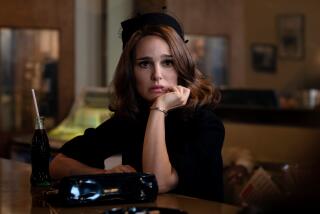The Industry’s Debt to Lucy : The comic, along with Arnaz, changed the face of situation comedy
- Share via
The death of Lucille Ball last Wednesday at 77 tugged the heartstrings of America and indeed the world. Tributes dubbed her the “Queen of Comedy.” Former President Ronald Reagan said: “Just the mention of her name brings a smile.”
Much has been said about Lucille Ball’s life, her popularity and her buoyantly dizzy comic style. But what has perhaps been lost in the past few days’ outpouring of emotion is the debt that the television industry owes to Ball and her long-time partner, Desi Arnaz. Among their many contributions was the pioneering of the situation-comedy form as we know it today.
“It (“I Love Lucy”) pioneered technically, creatively and financially,” said Michael Dann, who was programming chief of the show’s network, CBS, from 1958 to 1962, just after the show ended its successful 1951-57 run. Black-and-white reruns of “I Love Lucy” are seen today in 117 cities in the United States and in 70 abroad.
“Really, Lucille Ball herself was a pioneer in television, coming to the medium in its infancy and taking full advantage of the medium,” said Kathryn Montgomery, assistant professor of film and television at UCLA. “Clearly, she was very innovative in developing an ensemble of writers and talent, actors, developing a style of performing before a live audience.”
CBS’ “I Love Lucy” was the first show to be filmed with three cameras before a live audience, a setup that has become a fixture in situation comedy. (There was no videotape back then.)
TV shows had been filmed and TV shows had had live audiences--but credit for bringing these together belongs to “I Love Lucy.”
“It started a whole kind of situation comedy that hadn’t been done on TV before,” said Madelyn Davis, one of the first staff writers on “I Love Lucy.” She spent the next 20 years writing for the subsequent “Lucy “ shows: “The Desi and Lucy Hour,” “The Lucy Show” and “Here’s Lucy.” “You could have really broad comedy, and the audience laughed --it was real laughs.”
Although the concept seems obvious now, filming a comedy in front of an audience was considered impossible until “Lucy” came along, said Bob Schiller, another “I Love Lucy” writer. “They (other producers) said it couldn’t be done because the lighting would be no good--there were a lot of naysayers,” Schiller said.
“But Desi always said: ‘Let’s try it.’ Desi and the show’s producer, Jess Oppenheimer, and (cinematographer) Karl (Papa) Freund, an Academy Award-winning cameraman, developed a system by which you could film in front of an audience.”
Schiller added that the live-audience idea was inspired by Arnaz’s dislike of the tinny canned laughter used in the slew of TV comedies produced by the Screen Gems studio during the era. “If he couldn’t get real laughs, Arnaz didn’t want them at all.”
And, according to the textbooks, “I Love Lucy” followed a shooting schedule that would become the prototype used by most situation-comedy producers: script read-throughs on Tuesday, rehearsals on Wednesday, technical and lighting run-throughs on Thursday and shooting Friday in front of an audience.
Said the Museum of Broadcasting’s Bob Batscha: “Jack Lemmon tells a wonderful story about how he had two 15-minute comedies on the air, and the network concluded that situation comedy was dead, and they were canceled. Then, the following year, along came ‘I Love Lucy.’ It definitely established the genre.”
The most important legacy of filming the show is preservation of the episodes them-selves, said UCLA’s Montgomery. Although some live television shows of the era were filmed for posterity by cameras placed in front of a TV screen during the actual broadcast, this procedure produced poor-quality reproductions. The “I Love Lucy” episodes remain clear and intact.
The filmed episodes also allowed “I Love Lucy” to become one of TV’s first shows to be syndicated. The series, after going off the air in 1957, was syndicated in 1962 by CBS Films, which later gave birth to the show’s current syndication company, Viacom Enterprises (also the syndicator of today’s most successful TV comedy, “The Cosby Show”).
Joseph Zaleski, Viacom’s president of domestic syndication, estimates that in all the years of its syndication the “Lucy” show has earned only 10% of what “Cosby” has already earned for Viacom in syndication. (Because the show predates the unionization of Hollywood, writers and others receive no residuals for the reshowings.)
Still, Zaleski said, the show remains a great asset to Viacom and is immensely popular with today’s audiences.
Michael Dann, CBS programming chief from 1958 to ‘62, said the show “built up an economic base for people to make millions and millions of dollars (in syndication with various shows). CBS was able to build up a huge syndication; it was followed by ‘Gunsmoke’ and other shows.”
Zaleski said, “The only problem with ‘I Love Lucy’ is that it’s not in color. That’s why you never see ‘Lucy’ reruns in early fringe (the early evening TV hours) or prime-time. The stations believe that people buy color sets, so therefore they want to see color programs. So what happens is ‘Lucy’ is relegated to the morning time periods when full (viewership) levels are not available.”
Behind the scenes, the “Lucy” show also provided the building blocks for a little empire that one day Ball would own. During the years the show was on the air, Arnaz expanded the family business to produce several other TV shows, including “The Whirlybirds,” “The Ann Sothern Show” and “The Sheriff of Cochise.” The shrewd Arnaz sold the “Lucy” reruns to CBS for $5 million (about $19.25 million in 1989 dollars). The couple also purchased RKO Studios, whose facilities became the home for more TV series, including “The Danny Thomas Show” and “My Three Sons.”
“In those days, Desilu (the Arnaz/Ball company) was an enormous property--they were like Witt-Thomas-Harris today, or any other major producer; they had more things going than any other studio,” said writer Schiller.
As the business built up, however, the marriage broke down. During the last year of the crumbling marriage, Ball became involved with comedian Gary Morton, who did the audience warm-ups for the show and who would become her husband of many years. “It was awkward,” Schiller said. In an amicable divorce settlement, Ball agreed to buy out Arnaz’s interest in the company, thus becoming by default the producer of the show and possibly the only woman ever to own a Hollywood studio.
More important, however, was Ball’s inspiration to other comedians, especially women, to attempt broad comedy and physical comedy. Her own inspirations, said Schiller, were Carole Lombard and dancer Ginger Rogers.
“I think one of the important things about the ‘Lucy’ show is it brought to American homes every week a genuinely funny woman, who could do physical comedy so brilliantly,” said producer Jay Sandrich, who worked as an assistant director on the show when he was in his mid-20s. Although in later years feminists criticized “I Love Lucy” as presenting a poor image of women, comedians such as Lily Tomlin have been proud to cite Ball as their comic favorite.
The “Lucy” show led to a few comic imitations featuring a zany woman in the lead, including the 1952-55 comedy “I Married Joan,” with Joan Davis and Jim Backus, and “Pete and Gladys,” starring red-haired Cara Williams and Harry Morgan. The antics of Lucy Ricardo and Ethel Mertz have often been compared to the popular 1970s comedy “Laverne and Shirley,” which later bred “Perfect Strangers,” with two male leads involved in “Lucy”-style slapstick high jinks.
But TV industry watchers agree that Ball’s comic influence over Hollywood ran much deeper than that. “She influenced almost every comic to come after her, whether it be Carol Burnett or Tomlin or the actors on ‘Saturday Night Live,’ ” Batscha of the Museum of Broadcasting said. “Her Lucy character is like Charlie Chaplin’s ‘Little Tramp’ figure. It is a classic, and it is a reference point. There aren’t a whole lot of characters like that which have transcended their format.”
Program executive Dann, who came to CBS from NBC during the heyday of “Lucy,” said that although tracking the success of “I Love Lucy” is easy, defining the spark that started the flame is a much more elusive task.
“I was not at CBS when the show first came on the air; I was at NBC, and we had a show on the air called ‘Lights Out,” sponsored by Amident, at 9 o’clock on Sunday night,” Dann reminisced. “Both the show and the toothpaste were tremendously popular-- everybody watched ‘Lights Out.’
“Then Desi and Lucy came on the air opposite that show, and ‘Lights Out’ was canceled,” Dann continued. “We at NBC were flabbergasted, we just couldn’t believe it. Here was this girl who wasn’t that famous, and this bongo player from Cuba--and it never lost its momentum. It was the first time we used the word ‘runaway’ to describe a show.”
More to Read
The complete guide to home viewing
Get Screen Gab for everything about the TV shows and streaming movies everyone’s talking about.
You may occasionally receive promotional content from the Los Angeles Times.






